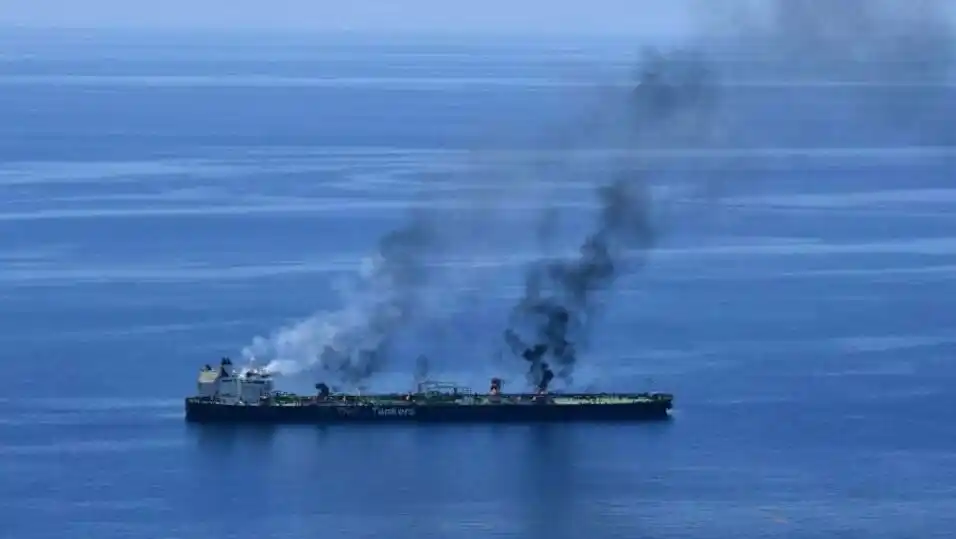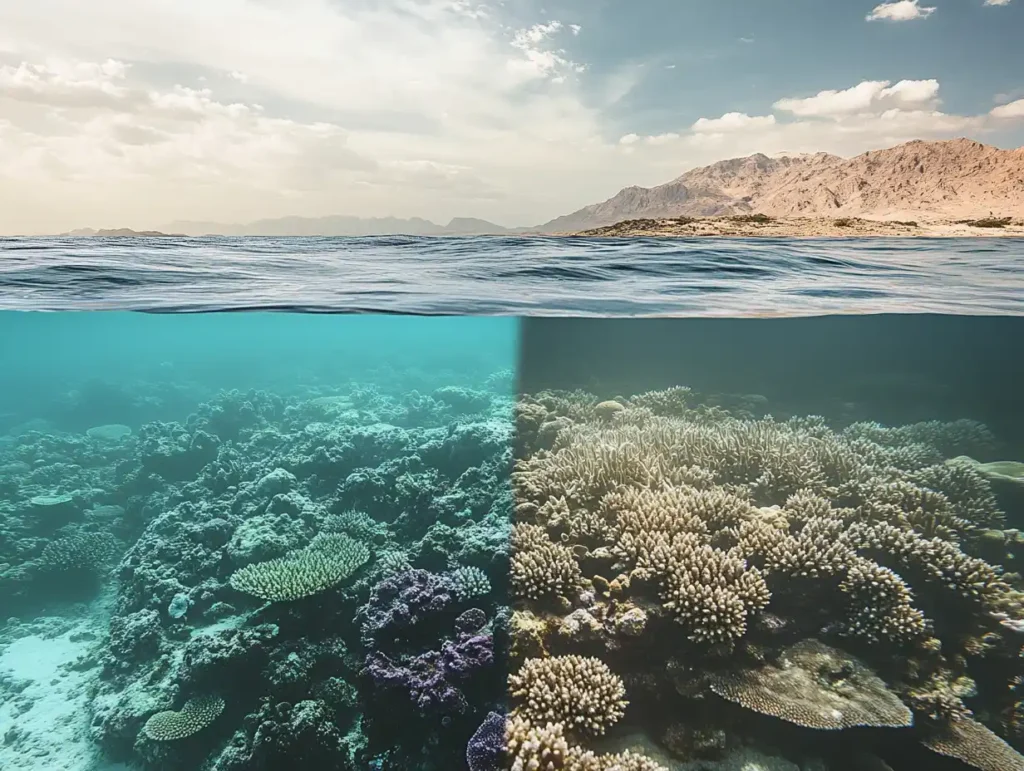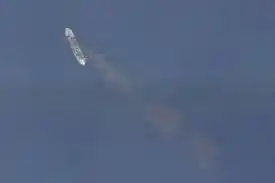The potential oil spill Red Sea disaster of 2024 began when Houthi militants attacked the Greek-flagged tanker Sounion, creating a major environmental crisis. The vessel carried approximately one million barrels of crude oil, which threatened catastrophic damage to the Red Sea’s fragile marine ecosystems. Though international salvage operations prevented a full-scale oil spill Red Sea disaster, the incident exposed the vulnerability of maritime shipping to regional conflicts. This deliberate attack violated international maritime law and demonstrated how geopolitical tensions directly endanger vital marine environments and global trade routes.
Table of Contents
Background of the Sounion Attack
On August 21, 2024, the oil tanker Sounion faced a deliberate attack while transiting through the Red Sea. Houthi militants targeted the vessel using small arms fire, projectiles, and a drone boat. The Houthis claimed the attack was justified because the ship had connections to companies delivering cargo to Israel, linking their actions to the broader Israel-Hamas conflict.
The assault caused immediate damage to the Sounion, resulting in a fire that burned for several weeks. The tanker lost engine power and propulsion, creating a dangerous situation where the vessel’s massive cargo of one million barrels of crude oil threatened to spill into the sensitive marine environment.
Unlike accidental oil spills caused by storms or navigation errors, this incident represented a deliberate act of environmental sabotage. The attackers showed complete disregard for the potential ecological catastrophe their actions could trigger in one of the world’s most biodiverse marine regions.

The Vessel and Its Vulnerable Cargo
The Sounion carried approximately 150,000 tons of crude oil when attacked. This massive volume represented a ticking environmental time bomb. If released, this oil could have created a spill potentially four times larger than the infamous Exxon Valdez disaster.
The tanker’s position in the southwest Red Sea placed it in a particularly vulnerable location. Ocean currents in this region could have quickly spread oil throughout the sea, affecting coastlines across multiple countries and devastating marine protected areas.
Oil Spill Red Sea: Environmental Risks and Ecosystem Threats
The Red Sea contains some of the world’s most unique and fragile marine ecosystems. A major oil spill in these waters would cause devastation far beyond what we’ve seen in other marine environments.
Unique Marine Biodiversity at Risk
The Red Sea hosts over 1,200 species of fish and more than 250 species of coral that exist nowhere else on Earth. These endemic species have adapted to the sea’s warm, salty waters over thousands of years. An oil spill would severely threaten these unique organisms, potentially leading to mass die-offs and even extinctions.
The region’s coral reefs are particularly vulnerable to oil pollution. These underwater ecosystems provide critical habitat for countless marine species and protect coastlines from erosion. Even small amounts of oil can damage corals by blocking sunlight and poisoning the tiny organisms that build reef structures.
The extensive coastal mangrove forests serve as critical nurseries for fish and protect shorelines from storms. Oil can suffocate mangrove roots and poison these important coastal buffers for years. The interconnected nature of these ecosystems means damage to one component can cascade through the entire marine food web.
Threats to Coastal Communities and Economies
Beyond ecological damage, a major oil spill Red Sea incident would devastate local fishing industries and tourism sectors that depend on healthy marine environments. Coastal communities across Egypt, Saudi Arabia, Yemen, and other nations rely on these waters for food security and economic survival.
The Red Sea supports vibrant diving tourism, with visitors traveling from around the world to experience its pristine underwater landscapes. Oil contamination would destroy this industry, eliminating jobs and economic opportunities across the region.

Salvage Operations and International Response
When the Sounion crew abandoned ship following the attack, they left behind a potential environmental catastrophe. Fortunately, a coordinated international response prevented the worst-case scenario.
Swift Action Prevents Catastrophe
The European Union’s naval mission, Operation Aspides, played a crucial role in the initial emergency response. They rescued the crew and quickly assessed the situation’s severity. Maritime security company Ambrey led the complex salvage operation that followed.
Extinguishing the fires aboard the burning tanker took nearly three weeks of dangerous work. Salvage teams then secured the damaged vessel and carefully towed it northward to Suez. There, they safely offloaded the remaining crude oil, preventing what could have been one of history’s worst maritime environmental disasters.
This successful intervention demonstrated the value of international cooperation in maritime emergencies. Without this coordinated response, the Red Sea would likely have suffered catastrophic contamination affecting generations of marine life.
Limitations in Regional Response Capabilities
Despite the successful salvage, the incident exposed gaps in regional preparedness for major oil spills. Few Red Sea nations possess the specialized equipment and trained personnel needed to address large-scale maritime pollution events. Many countries in the region lack comprehensive oil spill contingency plans and dedicated response vessels.
The remote location of the attack also complicated response efforts. Specialized salvage teams had to travel significant distances to reach the stricken vessel, delaying critical intervention time. Each day of delay increased the risk of structural failure and catastrophic oil release.
Comparison with Other Maritime Oil Spills
The Sounion incident differs from other recent maritime disasters in both cause and potential impact. Understanding these differences helps contextualize the threats facing global shipping lanes.
The Black Sea Mazut Spill: Different Causes, Similar Threats
In December 2024, the Black Sea experienced a major environmental disaster when two aging Russian tankers, the Volgoneft-212 and Volgoneft-239, broke apart during a severe storm in the Kerch Strait. This incident released approximately 3,000 tonnes of mazut, a thick, heavy fuel oil used in shipping, into sensitive coastal ecosystems.
Unlike the deliberate attack on the Sounion, the Black Sea spill resulted from operating outdated vessels in dangerous weather conditions. The Russian tankers, part of a “shadow fleet” used to circumvent international sanctions, were over 50 years old and poorly maintained. The Volgoneft-212 had undergone questionable structural modifications that likely contributed to its catastrophic failure.
The mazut spill caused severe ecological damage, killing thousands of birds and dozens of dolphins. Cleanup efforts faced significant challenges due to mazut’s thick, sticky nature, which makes it particularly difficult to remove from water and shorelines.
The North Sea Collision: Accidental vs. Deliberate Risks
Another recent incident occurred in March 2025 when the oil tanker Stena Immaculate collided with the cargo ship Solong in the North Sea. This collision resulted in a spill of aviation fuel and raised concerns about potential release of hazardous chemicals.
The North Sea incident, like many maritime accidents, stemmed from navigation errors, technical failures, or human mistakes. The captain of the Solong faced charges including manslaughter for his role in the collision.
While these accidental spills create serious environmental problems, the deliberate targeting of oil tankers represents a more troubling trend. When vessels become targets in regional conflicts, the risk of catastrophic environmental damage increases significantly, and maritime security becomes intertwined with environmental protection.
Geopolitical Implications of an Oil Spill Red Sea Crisis
The attack on the Sounion highlights how regional conflicts increasingly threaten global shipping and environmental safety. This incident occurred within a broader pattern of maritime insecurity in the Red Sea.
Disruption of Critical Global Shipping Routes
The Red Sea connects to the Mediterranean via the Suez Canal, forming one of the world’s most vital shipping corridors. Approximately 12% of global trade and 30% of global container traffic passes through this route annually. Attacks on vessels in this region disrupt supply chains worldwide.
Following the Sounion attack and similar incidents, many shipping companies diverted their vessels around the Cape of Good Hope rather than risk passage through the Red Sea. These longer routes increased shipping costs, created delays, and generated higher carbon emissions from extended transit times.
The growing danger in Asia’s waters presents similar challenges to global maritime commerce. When vital shipping lanes become militarized zones, the entire international trading system suffers alongside environmental security.
Houthi Capabilities and Regional Destabilization
The Sounion attack demonstrated the Houthis’ growing capacity to threaten international shipping with increasingly sophisticated weapons and tactics. Their ability to target specific vessels far from shore represents a significant escalation in maritime threats.
By targeting oil tankers, the Houthis weaponized environmental risk as part of their broader geopolitical strategy. This approach threatens not just individual vessels but entire marine ecosystems and the communities that depend on them.
International naval operations like the EU’s Operation Aspides provide some protection for commercial shipping. However, these military responses address symptoms rather than underlying causes of regional instability driving attacks on maritime traffic.
Preventing Oil Spill Red Sea Disasters: Strategic Approaches
Protecting the Red Sea from oil spill disasters requires comprehensive strategies addressing both security threats and environmental preparedness.
Enhanced Maritime Security Measures
Securing vital shipping lanes requires coordinated international efforts. Naval patrols, improved intelligence sharing, and escort systems for vulnerable vessels all help reduce attack risks. Advanced monitoring technologies, including satellite surveillance and drone reconnaissance, enable earlier detection of threats to tankers and other vessels.
Maritime 4.0 cybersecurity innovations offer additional protection layers for modern shipping. Digital systems can help vessels avoid dangerous areas, coordinate with security forces, and respond more effectively to emerging threats.
Building Regional Oil Spill Response Capacity
Even with improved security, accidents and attacks will occasionally occur. Red Sea nations must develop robust oil spill response capabilities, including:
- Dedicated response vessels strategically positioned throughout the region
- Stockpiles of containment equipment and dispersants
- Trained personnel ready to deploy rapidly
- Coordinated regional contingency plans
- Regular joint training exercises
These preparations require significant investment but cost far less than cleaning up after a major spill. International organizations can provide technical assistance and funding to help build this critical infrastructure.
Strengthening International Legal Frameworks
Attacks on commercial shipping violate international maritime law. The international community must strengthen enforcement mechanisms and impose meaningful consequences on groups and states that target vessels.
Similarly, international standards for tanker safety, crew training, and pollution prevention need consistent enforcement. Aging vessels and substandard operations increase environmental risks in all maritime regions.
Big data analytics in shipping can help identify patterns, predict potential threats, and improve both security and environmental protection through better information sharing and analysis.
Protecting Vital Maritime Environments
The 2024 attack on the Sounion tanker served as a stark warning about the environmental vulnerabilities created by regional conflicts. Though a catastrophic oil spill Red Sea disaster was narrowly avoided, the incident highlights the fragility of marine ecosystems when caught in geopolitical crossfires.
As shipping continues to face threats from various actors, the international community must prioritize both maritime security and environmental protection. These goals are increasingly intertwined – we cannot achieve one without the other.
The Red Sea’s unique biodiversity represents a global treasure worth protecting. Its coral reefs, mangrove forests, and thousands of marine species deserve our collective efforts to prevent environmental disasters, whether caused by accidents or deliberate attacks.
By investing in prevention, preparedness, and response capabilities, we can better safeguard this critical maritime environment for future generations while maintaining the vital shipping lanes that support global commerce.


Leave a Reply